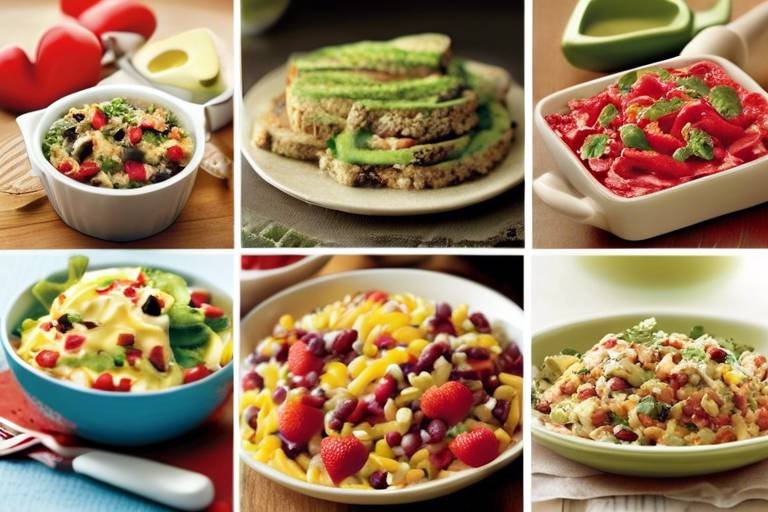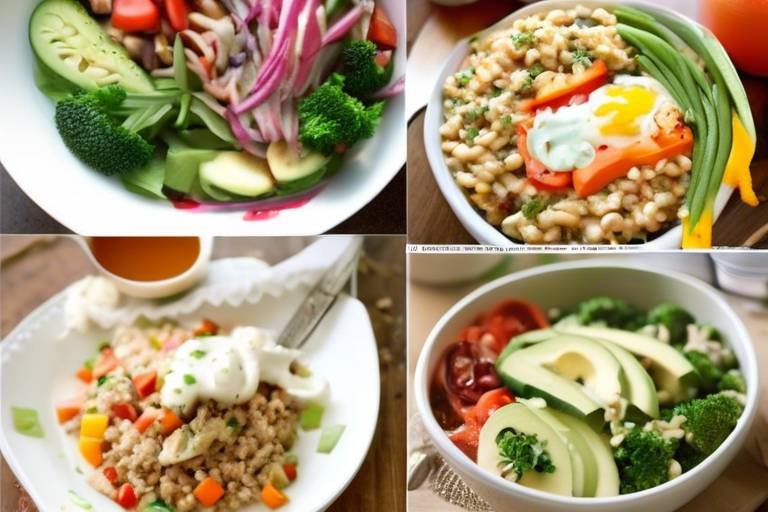Heart-Healthy Recipes Your Family Will Love
Discovering delicious and nutritious heart-healthy recipes that your family will enjoy is like finding a hidden treasure in your kitchen! It’s not just about eating well; it’s about creating meals that bring everyone together while promoting cardiovascular health. Imagine the joy on your loved ones' faces when they savor each bite of a meal that’s not only tasty but also good for their hearts. In this article, we’ll dive into a world of flavors that satisfy your cravings without compromising on health.
Eating heart-healthy doesn’t mean sacrificing flavor or fun at the dinner table. In fact, it opens up a realm of culinary possibilities! Think about vibrant salads bursting with colors, hearty whole grain pasta dishes, and sumptuous fruit desserts that make your heart sing. The key is to focus on fresh ingredients and smart cooking techniques that enhance the natural flavors of the food. So, roll up your sleeves and get ready to whip up some meals that your family will not only love but will also feel great about eating!
Throughout this article, we will explore various aspects of heart health, including the essential nutrients that support it, the benefits of a heart-healthy diet, and a collection of family-friendly recipes that are easy to prepare. Whether you’re a seasoned chef or a kitchen novice, you’ll find something here that makes your cooking experience enjoyable and rewarding. So, let’s embark on this delicious journey towards a healthier heart!

Understanding Heart Health
When it comes to our bodies, the heart is like the engine of a car; it powers everything we do and keeps us moving forward. Understanding heart health is crucial because it directly impacts our overall well-being. The heart pumps blood throughout the body, delivering oxygen and nutrients to our organs and tissues while removing waste. However, various factors can affect its efficiency, leading to serious health issues. So, what should we be aware of when it comes to maintaining a healthy heart?
First and foremost, dietary choices play a significant role in cardiovascular wellness. The foods we consume can either support heart health or contribute to problems like high blood pressure, high cholesterol, and even heart disease. It's essential to recognize that not all fats are created equal; while trans fats and saturated fats can be detrimental, healthy fats like those found in avocados and nuts can be beneficial. Additionally, incorporating a variety of fruits and vegetables into our meals provides essential vitamins and minerals that help keep our hearts in top shape.
Moreover, physical activity is another vital component of heart health. Regular exercise strengthens the heart muscle, improves circulation, and helps maintain a healthy weight. The American Heart Association recommends at least 150 minutes of moderate aerobic activity each week. But don't worry, you don't have to hit the gym every day; even simple activities like walking, dancing, or gardening can make a difference!
To put it simply, heart health is influenced by a combination of nutrition, exercise, and lifestyle choices. Here are some key factors to consider:
- Balanced Diet: Focus on whole foods, including lean proteins, whole grains, and plenty of fruits and vegetables.
- Regular Exercise: Aim for a mix of aerobic and strength-training activities.
- Avoid Smoking: Smoking is a significant risk factor for heart disease.
- Limit Alcohol Consumption: Drink in moderation, as excessive alcohol can lead to high blood pressure.
In summary, understanding heart health isn't just about avoiding bad habits; it’s about embracing a lifestyle that promotes a strong and resilient heart. By making informed choices about what we eat and how we move, we can significantly reduce our risk of heart disease and enjoy a healthier, more vibrant life.

Benefits of a Heart-Healthy Diet
When it comes to our health, the heart is the unsung hero, tirelessly pumping blood and keeping us alive. So, why not give it the love and care it deserves? Adopting a heart-healthy diet can be a game-changer for your overall well-being. Imagine your body as a high-performance car; it needs the right fuel to run smoothly. Just like premium gasoline helps a car perform better, a heart-healthy diet fuels your body with the nutrients it needs to thrive.
One of the most significant benefits of a heart-healthy diet is its ability to reduce the risk of heart disease. By incorporating foods rich in omega-3 fatty acids, fiber, and antioxidants, you can help lower blood pressure and cholesterol levels. This diet not only helps in preventing heart disease but also aids in managing existing conditions. Think of it as a protective shield around your heart, keeping it safe from the harmful effects of unhealthy eating habits.
Moreover, a heart-healthy diet can significantly assist in weight management. By focusing on whole foods like fruits, vegetables, and whole grains, you naturally consume fewer calories while still feeling full and satisfied. This is because these foods are high in fiber, which keeps you feeling full longer. Just picture yourself enjoying a vibrant salad loaded with colorful veggies—it’s not just a meal; it’s a feast for your heart and your taste buds!
But wait, there's more! A heart-healthy diet can improve your cholesterol levels. Foods rich in soluble fiber, such as oats and beans, can help lower LDL (bad) cholesterol while boosting HDL (good) cholesterol. This balance is crucial for maintaining a healthy heart. It’s like tuning a musical instrument; when everything is in harmony, the sound is beautiful. In this case, a harmonious cholesterol level leads to a healthier you.
Additionally, let’s not forget about the impact on energy levels and mental clarity. When you nourish your body with wholesome foods, you’ll find yourself feeling more energetic and focused throughout the day. A diet high in fruits and vegetables provides essential vitamins and minerals that are vital for brain health. It’s like giving your brain a refreshing drink of water—it wakes it up and keeps it functioning at its best!
| Benefit | Description |
|---|---|
| Reduced Risk of Heart Disease | Lower blood pressure and cholesterol levels through nutrient-rich foods. |
| Weight Management | High fiber foods keep you full, leading to fewer calorie intakes. |
| Improved Cholesterol Levels | Balancing LDL and HDL cholesterol for better heart health. |
| Increased Energy | Wholesome foods boost energy and enhance mental clarity. |
In summary, the benefits of a heart-healthy diet are not just about avoiding heart disease; they encompass a holistic approach to well-being. By making conscious dietary choices, you're not just adding years to your life; you're adding life to your years. So, why not start today? Your heart will thank you!
- What are some examples of heart-healthy foods? Foods rich in omega-3s, whole grains, fruits, and vegetables are excellent choices.
- Can a heart-healthy diet help with weight loss? Absolutely! These foods are nutrient-dense and can help you feel full while consuming fewer calories.
- How can I start incorporating heart-healthy meals into my diet? Begin by replacing processed foods with whole foods and planning meals that include plenty of fruits and vegetables.

Essential Nutrients for Heart Health
When it comes to maintaining a healthy heart, understanding the essential nutrients that support cardiovascular wellness is crucial. Think of your heart as a finely tuned engine; just like a car needs the right fuel to run smoothly, your body requires specific nutrients to keep your heart functioning at its best. These nutrients not only contribute to heart health but also play a significant role in preventing heart disease and improving overall well-being.
One of the most important nutrients for heart health is omega-3 fatty acids. Found in fatty fish like salmon, mackerel, and sardines, these healthy fats are known for their ability to reduce inflammation and lower triglyceride levels. Imagine omega-3s as a protective shield for your heart, fighting off the bad guys that can lead to heart issues. If fish isn't your thing, don't worry! You can also find omega-3s in flaxseeds, chia seeds, and walnuts, making it easy to incorporate them into your diet.
Another vital nutrient is fiber. This powerhouse nutrient is essential for maintaining healthy cholesterol levels and regulating blood sugar. Foods high in fiber, such as whole grains, fruits, and vegetables, can help you feel full longer, making them an excellent choice for weight management. Think of fiber as a broom that sweeps away excess cholesterol and keeps your digestive system running smoothly. Aim for at least 25 grams of fiber a day to give your heart the support it needs.
Antioxidants are also key players in heart health. These compounds, found abundantly in fruits and vegetables, help combat oxidative stress and inflammation in the body. Berries, dark chocolate, and green tea are rich in antioxidants and can be delicious additions to your diet. Imagine antioxidants as tiny warriors, battling the damage caused by free radicals and keeping your heart safe from harm.
To give you a clearer picture of these essential nutrients, here's a brief overview:
| Nutrient | Sources | Benefits |
|---|---|---|
| Omega-3 Fatty Acids | Fatty fish, flaxseeds, walnuts | Reduces inflammation, lowers triglycerides |
| Fiber | Whole grains, fruits, vegetables | Improves cholesterol, aids digestion |
| Antioxidants | Berries, dark chocolate, green tea | Fights oxidative stress, reduces inflammation |
In addition to these nutrients, potassium and magnesium are also essential for heart health. Potassium helps regulate blood pressure, while magnesium plays a role in maintaining a steady heartbeat. Foods rich in these minerals include bananas, spinach, and nuts. By incorporating a variety of these nutrient-dense foods into your meals, you can create a heart-healthy diet that not only tastes great but also nourishes your body.
Ultimately, focusing on these essential nutrients is like laying a strong foundation for your heart. By choosing foods that are rich in omega-3s, fiber, antioxidants, and key minerals, you're not just eating for today—you're investing in a healthier tomorrow. So, the next time you're planning a meal, remember to load up on these heart-friendly ingredients and watch your family's health thrive!
1. What are the best sources of omega-3 fatty acids?
The best sources include fatty fish such as salmon, mackerel, and sardines, as well as plant-based options like flaxseeds, chia seeds, and walnuts.
2. How much fiber should I aim for daily?
Aiming for at least 25 grams of fiber each day is recommended for optimal heart health and digestive function.
3. Can I get enough antioxidants from supplements?
While supplements can help, it's best to get antioxidants from whole foods like fruits and vegetables for maximum benefit.
4. How does potassium affect heart health?
Potassium helps regulate blood pressure, which is crucial for preventing heart disease and maintaining overall cardiovascular health.

Fruits and Vegetables
When it comes to maintaining a heart-healthy diet, fruits and vegetables are your best friends. These vibrant foods are not just colorful additions to your plate; they are powerhouses of nutrition that can significantly improve your cardiovascular health. Imagine your heart as a high-performance engine. Just like a car needs the right fuel to run smoothly, your heart requires a steady supply of vitamins, minerals, and antioxidants to function optimally. Fruits and vegetables provide this essential fuel, helping to prevent heart disease and maintain overall wellness.
One of the most remarkable aspects of fruits and vegetables is their rich content of antioxidants. These compounds combat oxidative stress in the body, which can lead to chronic diseases, including heart problems. For example, berries, such as blueberries and strawberries, are loaded with antioxidants that help reduce inflammation and lower blood pressure. Similarly, leafy greens like spinach and kale are packed with nutrients that support heart health, making them essential components of your meals.
Additionally, fruits and vegetables are high in fiber, which plays a crucial role in heart health. Fiber helps lower cholesterol levels and keeps your digestive system running smoothly. Foods like apples, pears, and carrots are excellent sources of soluble fiber, which can bind to cholesterol and help remove it from your body. This is where the magic happens; by simply incorporating more fruits and vegetables into your diet, you can lower your risk of heart disease while enjoying delicious meals.
To give you a clearer picture, here’s a quick breakdown of some heart-healthy fruits and vegetables:
| Fruit/Vegetable | Key Benefits |
|---|---|
| Blueberries | Rich in antioxidants, helps lower blood pressure. |
| Spinach | High in vitamins and minerals, supports overall heart function. |
| Avocado | Contains healthy fats that can improve cholesterol levels. |
| Oranges | High in vitamin C and potassium, supports blood vessel health. |
Incorporating a variety of colors in your meals is not just visually appealing; it also ensures that you’re getting a wide range of nutrients. Think of your plate as a palette—each color represents different vitamins and minerals that contribute to your heart health. For instance, red bell peppers are high in vitamin C, while purple eggplants contain antioxidants that can help reduce the risk of heart disease.
So, how can you make sure your family is getting enough fruits and vegetables? It’s simpler than you might think! Start by adding them to every meal. Toss some spinach into your morning smoothie or serve a colorful salad alongside dinner. You can also encourage your kids to snack on fruits instead of chips. After all, who wouldn’t want to munch on a juicy apple or a handful of sweet grapes? The key is to make fruits and vegetables a regular part of your meals, and soon enough, your family will not only enjoy them but also reap the heart-healthy benefits.

Whole Grains
Whole grains are not just a trendy health food; they are a fundamental component of a heart-healthy diet that can make a significant difference in your family's overall health. Unlike refined grains, which have been stripped of their nutritious bran and germ, whole grains retain all parts of the grain, providing a wealth of essential nutrients and fiber. This means that when you choose whole grains, you're not only fueling your body with energy but also giving it the tools it needs to maintain a healthy heart.
Incorporating whole grains into your meals can be as simple as swapping out white rice for brown rice or choosing whole grain bread instead of its white counterpart. The benefits are numerous, and they go beyond just heart health. Whole grains are known to help in regulating blood sugar levels, which is crucial for preventing diabetes—a condition closely related to heart disease. They also aid in weight management, as the fiber content in whole grains keeps you feeling full longer, reducing the likelihood of unhealthy snacking.
Here are some popular whole grains you might consider adding to your family’s diet:
- Quinoa: A complete protein that’s gluten-free and packed with fiber.
- Brown Rice: A versatile grain that can be used in a variety of dishes.
- Oats: Perfect for breakfast, oats are high in beta-glucans, which can help lower cholesterol.
- Barley: A hearty grain that adds a chewy texture to soups and salads.
- Whole Wheat: Used in bread, pasta, and baked goods, whole wheat flour is a great substitute for refined flour.
To illustrate the nutritional benefits of whole grains, let’s take a look at a quick comparison table:
| Grain | Fiber (per cup cooked) | Protein (per cup cooked) | Key Nutrients |
|---|---|---|---|
| Quinoa | 5g | 8g | Magnesium, Iron, B Vitamins |
| Brown Rice | 3.5g | 5g | Magnesium, Selenium |
| Oats | 4g | 6g | Thiamin, Manganese, Phosphorus |
| Barley | 6g | 3.5g | Selenium, Copper, B Vitamins |
| Whole Wheat | 6g | 6g | Iron, Zinc, B Vitamins |
As you can see, whole grains are not only rich in fiber and protein but also packed with essential vitamins and minerals that are vital for maintaining a healthy heart. By making the switch to whole grains, you are taking a proactive step towards improving your family’s heart health while also enjoying delicious meals. So why not start today? Experiment with recipes that feature these grains, and watch how your family embraces the delightful flavors and textures they offer.

Healthy Cooking Techniques
When it comes to preparing heart-healthy meals, the way you cook can make all the difference. It's not just about what you eat, but how you prepare it that plays a crucial role in maintaining cardiovascular health. Think of cooking techniques as the secret ingredients that can transform an ordinary dish into a heart-friendly feast! By choosing the right methods, you can enhance flavors while preserving the nutritional value of your ingredients.
One of the best techniques is grilling. This method allows excess fats to drip away from your food, making it a healthier option compared to frying. Imagine biting into a juicy grilled chicken breast, seasoned with your favorite herbs and spices. Not only is it delicious, but it’s also a great way to keep your meals light and heart-friendly. Plus, grilling vegetables brings out their natural sweetness, making them incredibly enjoyable!
Steaming is another fantastic cooking technique that retains the nutrients in your food. When you steam vegetables, for instance, they maintain their vibrant colors and crunchiness, along with their essential vitamins and minerals. It’s like giving your veggies a spa day! Steaming is perfect for broccoli, carrots, and even fish, which can become tender and flaky without the need for added fats.
Then we have baking, which is a versatile method that can be used for everything from whole grain breads to savory casseroles. Baking allows you to create delicious meals without the need for excessive oils or butters. For example, try baking a sweet potato; it becomes naturally sweet and creamy, perfect for a heart-healthy side dish. And when you’re in the mood for dessert, opt for baked fruits with a sprinkle of cinnamon instead of sugary treats!
Another technique worth mentioning is sautéing with a splash of broth or water instead of oil. This method can be a game-changer for cooking vegetables or lean proteins. It’s like giving your meals a flavor boost without the added calories. Just toss your veggies in a pan, add a little broth, and watch them come to life! You’ll end up with a vibrant, nutrient-packed dish that’s bursting with flavor.
Incorporating these healthy cooking techniques into your daily routine doesn’t have to be overwhelming. Start by picking one or two methods that resonate with you, and gradually experiment with them in your meal prep. You’ll be amazed at how enjoyable and satisfying heart-healthy cooking can be. Remember, the key is to keep it simple and fun, turning mealtime into a delightful experience for the whole family!
- What are the best oils to use for heart-healthy cooking? Olive oil and avocado oil are excellent choices due to their high levels of monounsaturated fats.
- Can I still enjoy flavorful meals while eating healthy? Absolutely! Using herbs, spices, and citrus can enhance the flavor of your dishes without adding extra calories.
- How can I make my meals more heart-healthy? Focus on incorporating more fruits, vegetables, whole grains, and lean proteins into your diet while reducing saturated fats and sugars.

Family-Friendly Heart-Healthy Recipes
When it comes to family meals, striking the right balance between deliciousness and nutritional value can be a challenge. But fear not! We've compiled a selection of heart-healthy recipes that are not only good for your cardiovascular health but also tantalizing enough to make your family members come back for seconds. Imagine a dinner table filled with vibrant colors, enticing aromas, and smiles all around—this is what these recipes aim to deliver!
One of the best parts about cooking heart-healthy meals is that you can still enjoy rich flavors without compromising on health. Think of it as a culinary adventure where you can explore new ingredients and cooking techniques that elevate your meals. For instance, instead of frying, consider grilling or baking your proteins. These methods not only cut down on unhealthy fats but also enhance the natural flavors of the ingredients. Plus, they’re super easy to master!
Let’s dive into some enticing recipes that are sure to please even the pickiest eaters:
- Quinoa and Black Bean Salad: This hearty salad is packed with protein and fiber. Toss together cooked quinoa, black beans, cherry tomatoes, diced bell peppers, and a squeeze of lime. It’s a refreshing dish that can be served warm or cold!
- Grilled Salmon with Asparagus: Salmon is a fantastic source of omega-3 fatty acids, which are essential for heart health. Simply season the salmon with herbs and grill it alongside fresh asparagus for a nutritious dinner that’s ready in under 30 minutes.
- Whole Wheat Pasta Primavera: Swap out regular pasta for whole wheat to boost fiber content. Sauté seasonal vegetables like zucchini, bell peppers, and carrots, toss them with whole wheat pasta, and finish with a drizzle of olive oil and a sprinkle of Parmesan cheese.
These recipes not only promote a healthy heart but also encourage family bonding time in the kitchen. Cooking together can be a fun way to teach kids about healthy eating habits while creating lasting memories. You might even find that your family members are more willing to try new foods when they’ve had a hand in preparing them!
But wait, there's more! You don’t have to stick to traditional recipes. Get creative and experiment with spices and herbs to enhance flavors without adding extra calories. For example, try using cumin and coriander in your roasted vegetables, or add a hint of cinnamon to your oatmeal for a warm, inviting breakfast. The possibilities are endless!
As you embark on this journey of heart-healthy cooking, remember that it’s not just about the food on your plate; it’s about the love and care you put into each meal. So gather your family, roll up your sleeves, and get cooking! You’ll be amazed at how delicious healthy eating can be.
Q: Can heart-healthy meals be tasty?
A: Absolutely! With the right ingredients and cooking methods, heart-healthy meals can be incredibly flavorful and satisfying.
Q: How can I get my kids to eat healthier?
A: Involve them in the cooking process, let them choose recipes, and encourage them to try new foods. Making it a fun activity can help them develop a taste for healthier options.
Q: Are there any quick heart-healthy recipes?
A: Yes! Many recipes can be prepared in under 30 minutes, such as grilled chicken with steamed vegetables or a quick stir-fry.

Breakfast Ideas
Starting your family's day off right with heart-healthy breakfast options is essential for maintaining energy levels and overall well-being. Breakfast is often dubbed the most important meal of the day, and for good reason! It sets the tone for the rest of the day, fueling both body and mind. Imagine waking up to the enticing aroma of whole grain pancakes or a vibrant smoothie bowl that not only satisfies your taste buds but also nourishes your heart. Sounds delightful, right?
One of the best ways to ensure a nutritious start is by incorporating a variety of ingredients that are rich in essential nutrients. For instance, consider whipping up a creamy oatmeal bowl topped with fresh berries and a sprinkle of chia seeds. This meal is not only comforting but also packed with fiber and antioxidants that promote heart health. Plus, it’s super easy to customize! You can mix and match toppings like sliced bananas, walnuts, or a drizzle of honey to suit your family’s preferences.
Another fantastic option is a hearty vegetable omelet. Eggs are a great source of protein, and when you load them up with colorful veggies like spinach, tomatoes, and bell peppers, you’re adding a wealth of vitamins and minerals. This dish can be quickly prepared and is perfect for those busy mornings when time is of the essence. You might even want to serve it alongside a slice of whole-grain toast topped with avocado, which provides healthy fats that are beneficial for your heart.
If your family enjoys smoothies, why not try a green smoothie that’s both delicious and nutritious? Blend together spinach, a banana, Greek yogurt, and a splash of almond milk for a refreshing drink that’s rich in fiber and protein. This smoothie is a fantastic way to sneak in those leafy greens without anyone even noticing. You can even freeze portions ahead of time to make mornings even easier!
To help you get started, here’s a quick reference table of some heart-healthy breakfast ideas:
| Breakfast Idea | Main Ingredients | Heart-Healthy Benefits |
|---|---|---|
| Whole Grain Pancakes | Whole wheat flour, oats, almond milk, berries | High in fiber and antioxidants |
| Vegetable Omelet | Eggs, spinach, tomatoes, bell peppers | Rich in protein and vitamins |
| Green Smoothie | Spinach, banana, Greek yogurt, almond milk | High in fiber and protein |
| Chia Seed Pudding | Chia seeds, almond milk, honey, nuts | Loaded with omega-3 fatty acids |
These breakfast ideas are not only heart-healthy but also incredibly versatile, making it easy to cater to your family’s tastes. Remember, a little creativity goes a long way in the kitchen, so don’t hesitate to experiment with different flavors and textures. Your family will appreciate the effort, and their hearts will thank you!
- What are some quick heart-healthy breakfast options? Quick options include overnight oats, smoothies, and yogurt with fruit and nuts.
- Are eggs good for heart health? Yes, eggs can be part of a heart-healthy diet when consumed in moderation, especially when paired with vegetables.
- How can I make my breakfast more nutritious? Add fruits, nuts, and whole grains to your meals to boost their nutritional value.

Dinner Favorites
When it comes to dinner, finding meals that are both delicious and heart-healthy can feel like a daunting task. But fear not! We've got some fantastic recipes that will make your taste buds dance while keeping your heart in tip-top shape. Imagine sitting down with your family, sharing stories around the table, and enjoying dishes that not only taste great but also nourish your body. Sounds perfect, right?
Let’s kick things off with a zesty lemon herb grilled chicken. This dish is not only simple to prepare, but it also packs a punch of flavor. Marinate chicken breasts in a mixture of fresh lemon juice, garlic, and a medley of herbs like rosemary and thyme. Grill them to juicy perfection, and serve with a side of steamed broccoli and quinoa. The combination of lean protein and fiber-rich grains will keep everyone satisfied and energized.
Another family favorite is vegetable stir-fry with tofu. This colorful dish is a feast for the eyes and the palate! Sauté a vibrant mix of bell peppers, carrots, and snap peas in a splash of low-sodium soy sauce. Add in some cubed tofu for protein and toss in a sprinkle of sesame seeds for that extra crunch. Serve it over brown rice or whole grain noodles for a wholesome meal that everyone will love.
And let’s not forget about baked salmon with a honey mustard glaze. Salmon is rich in omega-3 fatty acids, which are fantastic for heart health. Simply brush the salmon fillets with a mixture of honey, Dijon mustard, and a hint of garlic, then bake until flaky. Pair this with a fresh spinach salad topped with walnuts and cranberries, and you’ve got a dinner that’s as nutritious as it is delicious.
For those chilly nights, a hearty lentil soup can warm you right up. Packed with protein and fiber, lentils are a powerhouse for heart health. Simmer them with diced tomatoes, carrots, and celery, seasoned with cumin and coriander for a flavor explosion. Serve with a slice of whole-grain bread for a complete meal that will leave everyone feeling cozy and satisfied.
To make dinner even more exciting, consider involving your family in the cooking process. Kids love to help in the kitchen, and it’s a great way to teach them about healthy eating. You can set up a little assembly line for making whole grain veggie pizzas. Use whole wheat pita or flatbreads as the base, and let everyone choose their favorite toppings from a selection of fresh veggies, lean meats, and low-fat cheese. Not only will this foster creativity, but it will also ensure that everyone gets to enjoy a meal tailored to their tastes.
Incorporating these heart-healthy dinner favorites into your weekly meal plan can be a game-changer. Not only are they easy to prepare, but they also provide essential nutrients that support cardiovascular health. So, gather your loved ones, roll up your sleeves, and get cooking!
Q: What are some easy heart-healthy dinner recipes?
A: Some easy options include grilled chicken with herbs, vegetable stir-fry with tofu, baked salmon, and lentil soup. These meals are not only nutritious but also simple to prepare.
Q: How can I make my family enjoy heart-healthy meals?
A: Involve your family in the cooking process and let them choose their favorite ingredients. Making meals fun and interactive can help everyone appreciate healthy eating.
Q: Are there any snacks that are heart-healthy?
A: Absolutely! Nuts, seeds, fruits, and whole-grain crackers are great heart-healthy snacks. They provide essential nutrients and keep you satisfied between meals.
Frequently Asked Questions
- What are heart-healthy recipes?
Heart-healthy recipes are meals specifically designed to promote cardiovascular health. They typically include ingredients that are low in saturated fats, cholesterol, and sodium while being rich in nutrients like fiber, omega-3 fatty acids, and antioxidants. Think of them as delicious meals that not only taste good but also do wonders for your heart!
- Why is a heart-healthy diet important?
A heart-healthy diet is essential because it helps reduce the risk of heart disease, high blood pressure, and other cardiovascular issues. By choosing the right foods, you can manage weight, improve cholesterol levels, and enhance overall well-being. It's like giving your heart a protective shield against potential problems!
- What are some essential nutrients for heart health?
Some vital nutrients for heart health include omega-3 fatty acids, fiber, antioxidants, and potassium. These nutrients work together to support cardiovascular function, lower inflammation, and maintain healthy blood pressure. Incorporating these into your meals is like fueling your body with the best ingredients for a strong heart!
- How can I make my meals more heart-healthy?
You can make your meals more heart-healthy by using cooking techniques like grilling, steaming, or baking instead of frying. Additionally, focus on incorporating more fruits, vegetables, and whole grains into your dishes. It's all about making small changes that can lead to big improvements in your heart health!
- Are there specific foods to avoid for heart health?
Yes, it's best to limit foods high in saturated fats, trans fats, and added sugars. This includes processed snacks, fatty cuts of meat, and sugary beverages. Think of it as cleaning out your pantry; the less junk you have, the better choices you can make for your heart!
- Can I still enjoy my favorite meals while eating heart-healthy?
Absolutely! Many heart-healthy recipes are designed to be flavorful and satisfying, so you won't feel deprived. You can often modify your favorite meals by using healthier ingredients or cooking methods. It's all about finding that perfect balance between taste and health!
- What are some easy heart-healthy breakfast ideas?
Some easy heart-healthy breakfast ideas include oatmeal topped with fresh fruits, smoothies made with leafy greens and berries, or whole-grain toast with avocado. These options are not only delicious but also provide the energy and nutrients you need to start your day right!
- How can I get my family to eat heart-healthy meals?
To get your family to eat heart-healthy meals, involve them in the cooking process and let them help choose recipes. Make the meals fun and colorful, and don't forget to highlight the delicious flavors! When everyone feels included, they're more likely to enjoy the healthy options.



















